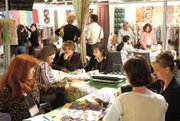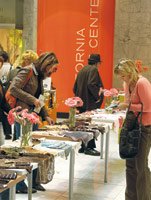Mood Light Despite Gray Skies at L.A. Textile Show
Neither rain nor fast-approaching fashion and market weeks kept designers and piece-goods buyers from turning out at the Los Angeles International Textile Show, held Oct. 18–20 at the California Market Center.
The show was held just days before the first Los Angeles Fashion Week events and a little over a week before the Oct. 29 start of Spring ’05 market week.
CMC officials declined to release attendance figures but said representatives from Blue Cult, Capital Tailors, Da- Nang, Hard Tail, JC Penney, James Perse, Juicy Couture, Karen Kane, Mervyn’s, Mon Petit Oiseau, Rozae Nichols, Tommy Hilfiger, Trina Turk and Warnaco were among the visitors. Also spotted browsing the fabric and trim vendors was Cynthia Vincent, J.P. & Mattie designer Mattie Ilel, Petro Zillia designer Nony Tochterman, Waraire Boswell, William Beranek, Kevan Hall, Naqada designer Octavio Carlin, David Cardona, Louis Verdad, Eva Franco, Solitude Clothing’s Shaun and Carla Tomson, as well as representatives from Richard Tyler, Steady, The Wet Seal, True Grit and Johnny Was.
The tight schedule meant many designers— particularly those staging runway shows during L.A. Fashion Week—had little time to visit the exhibitors housed on the 13th floor, in the fashion theater, in the exhibition hall and in permanent showrooms throughout the building. Verdad said he had two hours to spend at the show. Hall gave himself three.
Most exhibitors said they were pleased with the show, but many said traffic seemed slightly off from the last show in April. The CMC does not release attendance figures, but trade show coordinator Yvette Beltran said she received positive feedback. “Overall it was a positive vibe and most people had a great show,” she said.
A CMC spokesperson said, “Our number of manufacturers in attendance was up by 14 percent and our number of designers was up by 19 percent.”
Movable show dates
One of the hot-button issues at the show was next year’s show dates. The CMC announced plans to move the show from its typical late-April date to March 21–23. The shift from April to March moves the Los Angeles show several weeks before the International Fashion Fabric Exhibition in New York and puts it immediately after Material World in Miami Beach, Fla. Material World is more of a global sourcing event, but it does include fabric exhibitors, including a few that also show in Los Angeles.
But the new dates’ proximity to French textile show Premiere Vision will cause problems for many importers and reps of European lines.
“Our collection may not be here in time,” said Frank J. Iovino, president of Miroglio Textiles USA, the New York office of the Italian fabric company.
“The California market is totally different than New York,” he said. “Customers are buying closer to season—especially in California. If the show is that early, they’ll want Spring/Summer [goods].”
The new earlier dates would work for Edward Gurevich, whose Los Angeles–based converting company, Impex Textile, imports fabrics from Eastern Europe, China, India and Korea.
“The end of April is way too late—a lot of customers are almost done,” he said. “We show Spring in January.”
Longtime show exhibitor Gera Gallico, who represents several French textile houses including E.S.F., Fabien Doligez, Billon Freres and Troulliet, agreed that earlier dates would help her Spring business.
“The later it is, the worse it is for Spring,” she said. “Two weeks for Spring makes a big difference.”
Beltran said the CMC is reviewing the dates. She said the new March dates were set after surveying several textile show exhibitors and attendees.
“Most people appreciated that we’re moving it up, but they wish it was in early April instead of March, that’s what we’re hearing.”
Beltran said reviewing—and possibly moving— the show dates for next season is an immediate priority and should be resolved within the coming weeks.
European draw
The European exhibitors were a big draw for many attendees.
The French Pavilion on the 13th floor featured 13 companies including AB Creations, Frantissor, Soieries Chambutaires, E.S.F., Billon Freres, J.B. Bernard, Goutarel, Sofileta, Deveaux, Chaine Et Trame/Tecmoda, Henitex and Sprintex.
On the first floor in the fashion theater, TexItalia, produced by the Italian Trade Commission, included Italian mills and trim vendors B.A.P., Bottonificio La Perla, Caverni & Gramigni, Cotonificio Veneto, Efilan, Eusebio, Fedora Group, Guest, Inwool Jersey, Its Artea, Mapel, Pacini Nello, Pinori Filati, Ricci 1925, Ritmotex, Seterie Argenti, Taiana Virgilio, Teseo and Tessilgodi.
“Usually I go to Europe for Premiere Vision and I usually come here just to see if I missed anything,” said Carla Tomson, designer for Carpinteria, Calif.–based Solitude Clothing.
Tomson said at the Los Angeles show she can take more time to review a line than she can in Paris.
That was the case for J.P. & Mattie designer Ilel, who picked up most of her Spring and Summer fabrics at Premiere Vision in September.
“Because PV is so crazy, I just saw something I didn’t see in Paris—I was very glad to see them here,” she said, adding that she could add only a few “last-minute Summer things.”
The show also provides opportunities for overseas mills looking to break into—or expand their presence in—the West Coast market.
That was the case for button and trim house La Perla, based in Empoli, near Florence, Italy.
This was the second time the company exhibited in Los Angeles as part of TexItalia, said representative Lisa Ragionieri.
“We have a New York office,” she said. “Now we are trying to get into the Los Angeles area. This show could be a chance to start real business [here].”
La Perla’s offerings including buttons, trim, buckles and crystal brooches attracted the attention of Verdad, who stopped by for a quick review of the line and to pick up a business card.
Francoise Damide, president of the New York–based Solstiss, which represents several high-end French textile collections, said he has seen the demand for European fabrics increase since he first joined the show in the mid-1990s.
“This is happening,” he said. “There’s momentum here on the customer side but also with more European exhibitors. The market has evolved from 10 years ago.”
When he started exhibiting at the Los Angeles textile show in the mid-’90s, designers and piece-goods buyers balked at his prices, which can range from $125 per yard up to $500 per yard for intricate, hand-beaded fabrics. Four years ago, Damide opened a Los Angeles office and hired rep John Marshall to cover the West Coast market.
Agneacute;s Elisabelair, international export manager for Espace Textile, which organizes the French Pavilion, said she hoped the European contingent at the show increases. Elisabelair said she would like to see a European Pavilion where designers could survey the offerings from mills all over the continent.
Talking technology
The show also featured a handful of technology exhibitors in the Exhibition Hall, which housed several trend forecasters, print houses and trim companies as well.
For several technology exhibitors, this was the third time showing at the textile show. Many joined the show during Technology By Design, a technology showcase organized by the California Fashion Association. Now that the CFA is no longer involved, the technology section of the show has decreased. But several exhibitors said there was enough business to make the show worthwhile.
“I was a little nervous because there were fewer technology exhibitors,” said ApparelLink founder Arnie Wachman. “The first time, there was Microsoft and FedEx. This time it’s just a few of the stalwarts.”
Still, the Los Angeles–based company saw traffic jump after hosting an early morning seminar demonstrating its virtual showroom software, which it licenses to apparel companies looking to build B2B Web sites.
Wachman said the company is working on a textile version of its software, which would allow textile representatives to show their lines to piece-goods buyers via the Internet.
Sal Minicucci, a representative with Glendale, Calif.–based software firm Apparel Magic, also noted the decrease in attendees but was pleased with those who stopped by his booth.
“The people who did come were serious about new technology, and we made a few sales at the show, which tells me the people who come are good, quality people,” he said.
Minucucci said several apparel executives stopped by after shopping the textile show. “We saw people coming in with swatches and color cards,” he said. “Part of their growth strategy is to update their software package or to get something new.”























